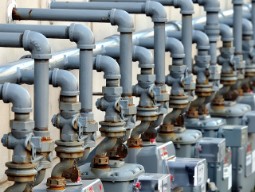Why Insulate Pipework ?

Pipework requires insulating for a number of reasons ;-
Condensation control
Where pipes operate at below ambient temperatures the potential exists for water vapour to condensate on the pipe surface. Moisture is known to contribute towards many different types of corrosion and so preventing the formation of condensation on pipework is usually considered important.
Pipe insulation can prevent condensation forming as the surface temperature of the insulation will vary from the surface temperature of the pipe. Condensation will not occur provided the insulation surface is above the dewpoint temperature of the air and the insulation incorporates some form of water vapour barrier or retarder that prevents water vapour from passing through the insulation to form on the pipe surface.
Pipe freezing
Since some water pipes are located either outside or in unheated areas where the ambient temperature may on occasion drop below the freezing point of water there is the potential for water in pipework to freeze. When water freezes it expands due to negative thermal expansion and this expansion can cause failure of a pipe system in one of a number of ways.
Pipe insulation cannot prevent the freezing of standing water pipes but it can increase the time before freezing can occur (reducing the risk of pipe freezing). For this reason it is recommended to insulate pipework at risk of freezing and local water supply regulations may require pipe insulation is applied to reduce the risk of pipe freezing.
Since smaller bore pipes contain a much smaller volume of water than larger pipes the time before freezing occurs is much less on smaller bore pipework. For this reason on smaller bore pipework insulation is typically used in combination with alternative methods of preventing pipe freezing (i.e. modulating trace heating cable or ensuring a consistent flow of water through the pipe).
Energy saving.
Since pipework can operate at temperatures far removed from the ambient temperature, and the rate of heat flow from a pipe is related to the temperature differential between the pipe and the surrounding ambient air, heat flow from pipework can be considerable. In many situations this heat flow is undesirable. The application of thermal pipe insulation introduces thermal resistance and reduces the heat flow.
Thickness's of thermal pipe insulation used for energy saving vary but as a general rule pipes operating at more extreme temperatures exhibit a greater heat flow and larger thickness's are applied due to the greater potential savings.
The location of pipework also influences the selection of insulation thickness. Heating pipework within a well insulated building, for instance, might in some circumstances not require insulation as the heat loss may be considered “useful” for heating the building as the heat “lost” is effectively trapped by the structural insulation anyway. Conversely such pipework may be insulated to prevent overheating or unnecessary cooling in the rooms through which it passes.
Protection against extreme temperatures.
Where pipework is operating at extremely high or low temperatures the potential exists for injury to occur should any person come into physical contact with the pipe surface. The threshold for human pain varies but several international standards set recommended touch temperature limits.
Since the surface temperature of insulation varies from the temperature of the pipe surface, pipe insulation can be used to bring surface touch temperatures into a safe range.
Control of noise.
Pipework can operate as a conduit for noise to travel from one part of a building to another (a typical example of this can be seen with waste water pipework routed within a building). Acoustic insulation can prevent this noise transfer by acting to damp the pipe wall and performing an acoustic decoupling function wherever the pipe passes through a fixed wall or floor and wherever the pipe is mechanically fixed.
Pipework can also radiate mechanical noise. In this circumstance the breakout of noise from the pipe wall can be achieved by acoustic insulation incorporating a high density sound barrier.